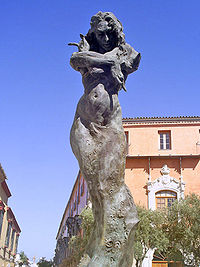Lola Flores
[2] Known for her overwhelming personality onstage, she debuted as a dancer at age sixteen at the stage production Luces de España, in her hometown.
In 1943 she obtained her breakthrough role in the musical stage production Zambra alongside Manolo Caracol, in which she sang original compositions by Rafael de León, Manuel López-Quiroga Miquel and Antonio Quintero, including "La Zarzamora" and "La Niña de Fuego", mostly singing flamenco music, copla, rumba and ranchera.
She is often cited as the "biggest exporter of Andalusian culture to date" as well as a "pioneer", being tributed many times in recent television series and documentaries such as the biographical film Lola, la Película (2007).
Shortly after leaving Jerez for Madrid, she rose to fame and soon signed the most expensive contract of the time (6 million pesetas in the 1950s) which launched her career, touring throughout Latin America.
Lola Flores, while one quarter gypsy through her maternal grandfather, Manuel, who was a street vendor, referred to herself as "paya" or non-gypsy Spanish.
Lola Flores, a native of Jerez de la Frontera (Cádiz) was an icon of traditional Andalusian folklore, recognized throughout Spain as well as internationally.
She became a famous dancer and singer of Andalusian folklore at a very young age, performing flamenco, copla, and chotis and appearing in films from 1939 to 1987.
Shortly after leaving Jerez for Madrid, she rose to fame and soon signed the biggest contract of the time (6 million pesetas in the 1950s) which launched her career touring throughout Latin America.
In 1943, with the protection of business owner Adolfo Arenaza, Flores set out a performance named Zambra with Manolo Caracol, which with small variations would be kept several years with great success.
It has gone down in history as an authoritative The New York Times review the following and famous quote that was never really written about her: "Lola Flores, a Spanish artist, she neither sings, and does not even dance, but you can't miss her".
The Spanish newspaper El País, conducted an investigation on the matter and concluded that it is part of the mythical history of the artist, but that this was never written in the New York Times.
The process had an important social transcendence, since she was a very famous person and was chosen by the Inland Revenue as an example of their battle against tax fraud.
One of the most remarkable films is a classic from the 40s: Embrujo [es] (1947), Carlos Serrano de Osma), a musical drama where she accompanies Manolo Caracol, who was her boyfriend in those days.
Casa Flora (1972, Ramón Fernández) and Una señora estupenda (1972, Julio Coll) are two of the most acceptable films of the period known as predestape in the Spanish comedian film industry; after this period she was the protagonist of the comedy Juana la loca... de vez en cuando (1983), where she would represent Isabella I of Castile, a very important Queen during the Spanish Inquisition, Truhanes (1983, Miguel Hermoso).
In this film, she shared experiences with the most remarkable icons of Flamenco, such as Camarón de la Isla or Rocío Jurado.
As well as the Spanish actresses Sara Montiel, Carmen Sevilla and Amparo Rivelles she played different roles in films in Mexico, when this country was living the Golden era of cinema.
Lola Flores worked with important celebrities such as Jorge Negrete, Pedro Infante, Antonio Badú, Luis Aguilar "El Gallo Giro" and Miguel Aceves Mejía.
[citation needed] The sisters Salazar, better known as Azúcar Moreno, paid tribute to her with a song that had and has still a great recognition in Spain and the entire world titled "Bailando con Lola".
The construction of a museum is being built in her memory in the Palace of Villapanés (next to her monument), which will house bibliography, multimedia and personal objects (dresses and enseres) of the artist.
[13][citation needed] In 2016, the Lara and Cajasol Foundations awarded the Manuel Alvar Prize for Humanistic Studies 2016 to the essay Lola Flores: Otra Historia del Espectáculo en la España Contemporánea by Alberto Romero Ferrer.
It features testimonies of 44 international and national performers including Rosalía, Mala Rodríguez, Miguel Poveda, Nathy Peluso, María José Llergo and C. Tangana among others.
[17] Flores died on 16 May 1995 at her residence "El Lerele" situated in La Moraleja, municipality of Alcobendas (Madrid), at the age of 72, due to breast cancer that had been diagnosed in 1972.
Fifteen days after her death, on 31 May 1995, her son Antonio Flores (aged 33) was found dead in the family residence of "El Lerele".



